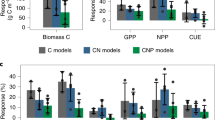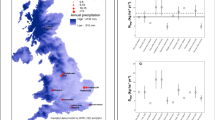Abstract
Whether increased photosynthates under elevated atmospheric CO2 could translate into sustained biomass accumulation in forest trees remains uncertain. Here we demonstrate how tree radial growth is closely linked to litterfall dynamics, which enhances nitrogen recycling to support a sustained effect of CO2 fertilization on tree-ring growth. Our ten-year observations in two alpine treeline forests indicated that annual (or seasonal) stem radial increments generally had a positive relationship with the previous year’s (or season’s) litterfall and its associated nitrogen return and resorption. Annual tree-ring width, annual litterfall and annual nitrogen return and resorption all showed an increasing trend during 2007–2017, and most of the variations were explained by elevated atmospheric CO2 rather than climate change. Similar patterns were found in the longer time series of tree-ring width index from 1986–2017. The regional representativeness of our observed patterns was confirmed by the literature data of six other tree species at 11 treeline sites over the Tibetan Plateau. Enhanced nitrogen recycling through increased litterfall under elevated atmospheric CO2 supports a general increasing trend of tree-ring growth in recent decades, especially in cold and nitrogen-poor environments.
This is a preview of subscription content, access via your institution
Access options
Access Nature and 54 other Nature Portfolio journals
Get Nature+, our best-value online-access subscription
$29.99 / 30 days
cancel any time
Subscribe to this journal
Receive 12 digital issues and online access to articles
$119.00 per year
only $9.92 per issue
Buy this article
- Purchase on Springer Link
- Instant access to full article PDF
Prices may be subject to local taxes which are calculated during checkout





Similar content being viewed by others
Data availability
The tree-ring width chronologies collected from the International Tree-Ring Data Bank are available at https://www.ncdc.noaa.gov/data-access/paleoclimatology-data/datasets/tree-ring. The time-series data of atmospheric CO2 concentration were obtained from https://www.esrl.noaa.gov/gmd/ccgg/trends/. The time-series data of monthly climatic factors at weather stations were obtained from http://data.cma.cn/data/detail/dataCode/A.0012.0001. All observed data in this study are provided in this article and its associated supplementary information.
References
Cole, C. T., Anderson, J. E., Lindroth, R. L. & Waller, D. M. Rising concentrations of atmospheric CO2 have increased growth in natural stands of quaking aspen (Populus tremuloides). Glob. Change Biol. 16, 2186–2197 (2010).
Urrutia-Jalabert, R. et al. Increased water use efficiency but contrasting tree growth patterns in Fitzroya cupressoides forests of southern Chile during recent decades. J. Geophys. Res. Biogeosci. 120, 2505–2524 (2015).
Cienciala, E. et al. Increased spruce tree growth in Central Europe since 1960s. Sci. Total Environ. 619–620, 1637–1647 (2018).
Mathias, J. M. & Thomas, R. B. Disentangling the effects of acidic air pollution, atmospheric CO2, and climate change on recent growth of red spruce trees in the Central Appalachian Mountains. Glob. Change Biol. 24, 3938–3953 (2018).
Körner, C. et al. Carbon flux and growth in mature deciduous forest trees exposed to elevated CO2. Science 309, 1360–1362 (2005).
Klein, T. et al. Growth and carbon relations of mature Picea abies trees under 5 years of free-air CO2 enrichment. J. Ecol. 104, 1720–1733 (2016).
Norby, R. J. & Zak, D. R. Ecological lessons from free-air CO2 enrichment (FACE) experiments. Annu. Rev. Ecol. Evol. Syst. 42, 181–203 (2011).
Peñuelas, J., Canadell, J. G. & Ogaya, R. Increased water-use efficiency during the 20th century did not translate into enhanced tree growth. Glob. Ecol. Biogeogr. 20, 597–608 (2011).
IPCC. Climate Change 2013: The Physical Science Basis (eds Stocker, T. F. et al.) (Cambridge Univ. Press, 2013).
Dong, N. et al. Rising CO2 and warming reduce global canopy demand for nitrogen. New Phytol. https://doi.org/10.1111/nph.18076 (2022).
Finzi, A. C., Allen, A. S., DeLucia, E. H., Ellsworth, D. S. & Schlesinger, W. H. Forest litter production, chemistry, and decomposition following two years of free-air CO2 enrichment. Ecology 82, 470–484 (2001).
Liberloo, M. et al. Elevated CO2 concentration, fertilization and their interaction: growth stimulation in a short-rotation poplar coppice (EUROFACE). Tree Physiol. 25, 179–189 (2005).
Hungate, B. A. et al. Nitrogen cycling during seven years of atmospheric CO2 enrichment in a scrub oak woodland. Ecology 87, 26–40 (2006).
Ainsworth, E. A. & Long, S. P. What have we learned from 15 years of free-air CO2 enrichment (FACE)? A meta-analytic review of the responses of photosynthesis, canopy properties and plant production to rising CO2. New Phytol. 165, 351–372 (2005).
Liberloo, M. et al. Coppicing shifts CO2 stimulation of poplar productivity to above-ground pools: a synthesis of leaf to stand level results from the POP/EUROFACE experiment. New Phytol. 182, 331–346 (2009).
McCarthy, H. R. et al. Re-assessment of plant carbon dynamics at the Duke free-air CO2 enrichment site: interactions of atmospheric [CO2] with nitrogen and water availability over stand development. New Phytol. 185, 514–528 (2010).
Dawes, M. A. et al. Species-specific tree growth responses to 9 years of CO2 enrichment at the alpine treeline. J. Ecol. 99, 383–394 (2011).
Luo, Y. Q. et al. Progressive nitrogen limitation of ecosystem responses to rising atmospheric carbon dioxide. Bioscience 54, 731–739 (2004).
Keenan, T. F. et al. Increase in forest water-use efficiency as atmospheric carbon dioxide concentrations rise. Nature 499, 324–327 (2013).
Luo, Y. Q., Hui, D. F. & Zhang, D. Q. Elevated CO2 stimulates net accumulations of carbon and nitrogen in land ecosystems: a meta-analysis. Ecology 87, 53–63 (2006).
Kikuzawa, K. A cost-benefit analysis of leaf habit and leaf longevity of trees and their geographical pattern. Am. Nat. 138, 1250–1263 (1991).
Wright, I. J. et al. The worldwide leaf economics spectrum. Nature 428, 821–827 (2004).
Luo, T. X. et al. Summer solstice marks a seasonal shift in temperature sensitivity of stem growth and nitrogen-use efficiency in cold-limited forests. Agric. For. Meteorol. 248, 469–478 (2018).
Rossi, S. et al. Conifers in cold environments synchronize maximum growth rate of tree-ring formation with day length. New Phytol. 170, 301–310 (2006).
Bauerle, W. L. et al. Photoperiodic regulation of the seasonal pattern of photosynthetic capacity and the implications for carbon cycling. Proc. Natl Acad. Sci. USA 109, 8612–8617 (2012).
Jarvis, P. & Linder, S. Constraints to growth of boreal forests. Nature 405, 904–905 (2000).
Sullivan, P. F., Ellison, S. B., McNown, R. W., Brownlee, A. H. & Sveinbjörnsson, B. Evidence of soil nutrient availability as the proximate constraint on growth of treeline trees in northwest Alaska. Ecology 96, 716–727 (2015).
Dodd, A. N. et al. Plant circadian clocks increase photosynthesis, growth, survival, and competitive advantage. Science 309, 630–633 (2005).
Jackson, S. D. Plant responses to photoperiod. New Phytol. 181, 517–531 (2009).
Chapin III, F. S., Matson, P. A. & Mooney, H. A. Principles of Terrestrial Ecosystem Ecology (Springer-Verlag, 2002).
Hikosaka, K. Leaf canopy as a dynamic system: ecophysiology and optimality in leaf turnover. Ann. Bot. 95, 521–533 (2005).
Jiang, M. K. et al. The fate of carbon in a mature forest under carbon dioxide enrichment. Nature 580, 227–231 (2020).
Guerrieri, R. et al. Disentangling the role of photosynthesis and stomatal conductance on rising forest water-use efficiency. Proc. Natl Acad. Sci. USA 116, 16909–16914 (2019).
Mathias, J. M. & Thomas, R. B. Global tree intrinsic water use efficiency is enhanced by increased atmospheric CO2 and modulated by climate and plant functional types. Proc. Natl Acad. Sci. USA 118, e2014286118 (2021).
Finzi, A. C. et al. Increases in nitrogen uptake rather than nitrogen-use efficiency support higher rates of temperate forest productivity under elevated CO2. Proc. Natl Acad. Sci. USA 104, 14014–14019 (2007).
Soulé, P. T. & Knapp, P. A. Radial growth rate increases in naturally occurring ponderosa pine trees: a late-20th century CO2 fertilization effect? New Phytol. 171, 379–390 (2006).
Linares, J. C. & Camarero, J. J. From pattern to process: linking intrinsic water-use efficiency to drought-induced forest decline. Glob. Change Biol. 18, 1000–1015 (2012).
Kagawa, A., Sugimoto, A. & Maximov, T. C. 13CO2 pulse-labelling of photoassimilates reveals carbon allocation within and between tree rings. Plant Cell Environ. 29, 1571–1584 (2006).
Epron, D. et al. Pulse-labelling trees to study carbon allocation dynamics: a review of methods, current knowledge and future prospects. Tree Physiol. 32, 776–798 (2012).
Wiley, E. & Helliker, B. A re-evaluation of carbon storage in trees lends greater support for carbon limitation to growth. New Phytol. 195, 285–289 (2012).
Rocha, A. V., Goulden, M. L., Dunn, A. L. & Wofsy, S. C. On linking interannual tree ring variability with observations of whole-forest CO2 flux. Glob. Change Biol. 12, 1378–1389 (2006).
Zweifel, R. et al. Link between continuous stem radius changes and net ecosystem productivity of a subalpine Norway spruce forest in the Swiss Alps. New Phytol. 187, 819–830 (2010).
Kong, G. Q., Luo, T. X., Liu, X. S., Zhang, L. & Liang, E. Y. Annual ring widths are good predictors of changes in net primary productivity of alpine Rhododendron shrubs in the Sergyemla Mountains, southeast Tibet. Plant Ecol. 213, 1843–1855 (2012).
Teets, A. et al. Linking annual tree growth with eddy-flux measures of net ecosystem productivity across twenty years of observation in a mixed conifer forest. Agric. For. Meteorol. 249, 479–487 (2018).
Luo, T. X., Li, M. C. & Luo, J. Seasonal variations in leaf δ13C and nitrogen associated with foliage turnover and carbon gain for a wet subalpine fir forest in the Gongga Mountains, eastern Tibetan Plateau. Ecol. Res. 26, 253–263 (2011).
Kobe, R. K., Lepczyk, C. A. & Iyer, M. Resorption efficiency decreases with increasing green leaf nutrients in a global data set. Ecology 86, 2780–2792 (2005).
Vergutz, L., Manzoni, S., Porporato, A., Novais, R. F. & Jackson, R. B. Global resorption efficiencies and concentrations of carbon and nutrients in leaves of terrestrial plants. Ecol. Monogr. 82, 205–220 (2012).
Holmes, R. L. Computer-assisted quality control in tree-ring dating and measurement. Tree-Ring Bull. 43, 69–78 (1983).
Cook, E. R. & Kairiukstis, L. A. Methods of Dendrochronology: Applications in the Environmental Sciences (Kluwer Academic Publishers, 1990).
Editorial Board of Vegetation Map of China, Chinese Academy of Sciences. Vegetation Atlas of China (Science Press, 2001).
Acknowledgements
We thank X. S. Liu for his help with the observation of stem radial increment and the Southeast Tibet Station for Alpine Environment Observation and Research, Chinese Academy of Sciences, for help in the fieldwork. This work was funded by the Second Tibetan Plateau Scientific Expedition and Research Programme (grant no. 2019QZKK0106) and the National Natural Science Foundation of China (grant nos. 41830649 and 41571046).
Author information
Authors and Affiliations
Contributions
T.L. designed the experiment. Y.G., L.Z., L.Y. and W.S. conducted the experiment. Y.G., L.Z., T.L., Y.P., I.J.W. and Y.L. analysed the data. Y.G., L.Z. and T.L. wrote the manuscript. Y.P., I.J.W. and Y.L. revised the manuscript.
Corresponding author
Ethics declarations
Competing interests
The authors declare no competing interests.
Peer review
Peer review information
Nature Ecology & Evolution thanks Flurin Babst and the other, anonymous, reviewer(s) for their contribution to the peer review of this work.
Additional information
Publisher’s note Springer Nature remains neutral with regard to jurisdictional claims in published maps and institutional affiliations.
Supplementary information
Supplementary Information
Supplementary Figs. 1–3 and Tables 1–6.
Rights and permissions
About this article
Cite this article
Guo, Y., Zhang, L., Yang, L. et al. Enhanced leaf turnover and nitrogen recycling sustain CO2 fertilization effect on tree-ring growth. Nat Ecol Evol 6, 1271–1278 (2022). https://doi.org/10.1038/s41559-022-01811-1
Received:
Accepted:
Published:
Issue Date:
DOI: https://doi.org/10.1038/s41559-022-01811-1
This article is cited by
-
Elevated CO2 levels promote both carbon and nitrogen cycling in global forests
Nature Climate Change (2024)
-
Evidence and attribution of the enhanced land carbon sink
Nature Reviews Earth & Environment (2023)
-
Nitrogen cycles in global croplands altered by elevated CO2
Nature Sustainability (2023)



